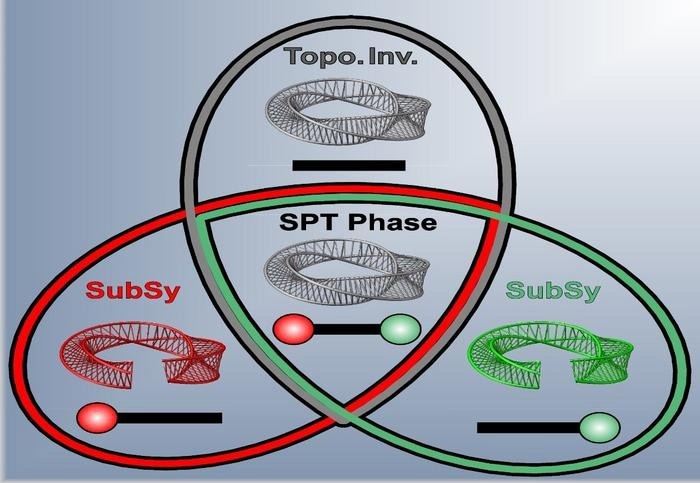A major development in the understanding of topological phases has been accomplished by an international team of researchers led by researchers at Nankai University in China, the University of Zagreb in Croatia, and Roberto Morandotti’s team at the Institut national de la recherche scientifique (INRS) in Canada.

Schematic illustration classifying perturbations in the symmetry-protected topological phase (SPT phase). The overlapping region surrounded by red, gray, and green lines represents a symmetry-protected topological phase featuring topological invariant and corresponding topological boundary states. The gray line is a set of perturbations affecting the boundary states but not breaking the topological invariant of the overall system. Red and green line areas show boundary states protected by their respectively associated sub-symmetry. The illustrated example shows two sets of perturbations that satisfy the sub-symmetry but destroy the topological invariant of the overall system. In this case, sub-symmetry protects boundary states. Image Credit: Domenico Bongiovanni and co-authors
Their research was recently published in the Nature Publishing Group journal Nature Physics.
Due to its exceptional potential for achieving high performance in terms of durability and stability while manipulating light, topological photonics has gained more and more attention over the past 10 years.
A new class of photonic devices, including topological lasers and cavities, that have topologically protected states that are impervious to flaws and diseases has been made possible due to topological photonics discoveries.
The term “topology” is borrowed from mathematics, where it is used to investigate an object's geometrical characteristics with regard to values that are maintained during continuous deformation.
When the surfaces of two objects can be continuously deformed into one another and vice versa, they are said to be topologically similar. For example, a torus and a coffee cup are equivalent from the perspective of topology.
It is possible to anticipate new topological states of matter and different topological materials in physics by using the idea of topology to characterize the energy band properties.
Different topological phases (trivial and nontrivial) are distinguished by appropriately introducing quantized topological invariants, which allow for the establishment of a link between bulk properties and the emergence of a feature at the boundary of these materials, known as the “bulk-boundary correspondence.”
The existence of resilient topological boundary states protected by unique spatial and/or inherent symmetries is the most distinguishing property of a nontrivial topology in this regard.
In general, it is considered that the close link between topological boundary states, topological invariants, and one or more overall symmetries is required for sustaining topological protection against perturbations in systems with symmetry-protected topological phase (SPT phase).
As a result, any deformation that breaks the underlying symmetry has an irreversible effect on both topological invariants and topological boundary states.
The multinational research team has challenged this previous common notion in this study, therefore broadening our knowledge of SPT boundary states.
They discovered that even if the system no longer contains quantized topological invariants and some types of global symmetry, topological boundary states can still exist in the relevant subspaces, shielded by “sub-symmetries.”
Our discovery challenges the common thinking of the symmetry-protected topological phase in topology and renews the correspondence of topological invariant and boundary states. Our idea has the potential to explain the topological origin of many unconventional states and can find application in different platforms and physical systems.
Domenico Bongiovanni, Study Investigator, Postdoctoral Researcher, Institut national de la recherche scientifique
The researchers discovered that global symmetry in the traditional sense is not entirely essential for the protection of topological boundary states by developing and studying the idea of sub-symmetry.
Topological boundary states are retained in this regard as long as the symmetries of specific subspaces are fulfilled, even though the general topological invariants are no longer present.
To fulfill the constraints of distinct subspace symmetries, the study team effectively devised and produced photonic lattice structures using a cw-laser writing approach.
The tests established proof of concept using two of the most common topological lattices: one-dimensional SSH lattices and two-dimensional Kagome lattices.
Furthermore, the team pioneered the notion of long-range coupling symmetry into the Kagome lattice model, resolving existing debates over the presence and topological protection of higher-order topological states in the Kagome lattice.
This work offers fresh perspectives on topological state research and applications in many physical contexts while also challenging conventional understandings of topological states protected by symmetry.
The results of this work are anticipated to have a positive influence on topological photonics’ advancement and that of its cutting-edge multidisciplinary disciplines, as well as on the investigation and creation of a new class of topological photonic devices based on boundary states that are sub-symmetry-protected.
About This Study
Ziteng Wang, Xiangdong Wang, Zhichan Hu, Domenico Bongiovanni, Dario Juki, Liqin Tang, Daohong Song, Roberto Morandotti, Zhigang Chen, and Hrvoje Buljan published a work titled “Sub-symmetry protected topological states” in the journal Nature Physics.
The National Key Research and Development Program of China, the National Natural Science Foundation of China, the Croatian Government and the European Union through the QuantiXLie Center of Excellence, the Natural Sciences and Engineering Research Council of Canada (NSERC), and the Canada Research Chairs Program (CRC) all provided financial support for the study.
Journal Reference:
Wang, Z., et al. (2023) Sub-symmetry-protected topological states. Nature Physics. doi:10.1038/s41567-023-02011-9